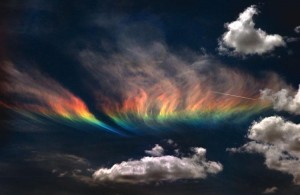A Rainbow on the Moon
Five weeks ago a crater from the LCROSS impact formed on the Moon.

Five weeks ago a crater from the LCROSS impact formed on the Moon. The pre-impact build-up had been sensational, but the actual event was largely invisible to observers on Earth. It was a different story on the Moon. The slowly growing impact ejecta curtain threw water ice particles and vapor far out into space. When the crater formed, flying ice particles could have refracted the glare of unfiltered sunlight into an “ice rainbow,” similar to those seen through very high altitude clouds on Earth. For a very brief time, a rainbow might have been visible to an observer standing on the lunar surface. And like its namesake, this rainbow is a promise – a promise that the Moon is habitable. It is an invitation to humanity to extend man's domain to our nearest planetary neighbor.
The LCROSS science team’s initial analysis of ejected impact plume data found evidence for water. It appears that several other species, particularly some carbon substances also found in the cores of comets, may be present. The new results suggest that some lunar polar volatiles may have their origins from outside the Moon, deposited there over millions of years by the impact of comets and asteroids.
Over the last 50 years, the idea of water ice at the lunar poles has generated as much angst as excitement within the scientific community. Ice on the Moon was suggested by Watson, Murray and Brown in 1960. They recognized that, regardless of the fate of such substances elsewhere on the Moon, the dark, cold floors of polar craters might retain volatile substances. Rock and soil samples returned by the Apollo missions were not only bone-dry, but crystallized in a very reducing environment, suggesting that any indigenous lunar water, if present, must have been a very minor component. Apollo scientist Jim Arnold resurrected the Watson et al. hypothesis forty years ago, concluding that their original proposal of water ice at the poles was still feasible and that a polar lunar orbiter was needed to search for such deposits.
We know that over geologic time, the Moon was bombarded by water-bearing objects. Meteorites contain water, and just as they’ve landed on Earth, they’ve also hit the Moon. Moreover, we’ve detected water vapor in the tails of comets with Earth-based telescopes. But it was widely speculated that all this water must be lost from the Moon, which left the issue of polar ice unresolved.
Fifteen years ago, the 1994 Clementine orbiter mission revived our interest in the Moon’s polar regions. When Clementine’s images of the Moon’s poles revealed large areas of shadowed terrain, it reminded Gene Shoemaker and the science team of the Watson and Arnold papers. Large shadowed areas suggested that polar cold traps might really exist, so an experiment was improvised using the spacecraft transmitter to beam RF energy into the shadowed areas. Analysis of the radio echoes suggested the presence of ice in shadowed areas near the south pole. This result was questioned, largely because our team couldn’t repeat the passes using the improvised experiment.
In 1998, Lunar Prospector found evidence for excess hydrogen in the surface soils of both lunar poles. These data could not show what form the hydrogen was in and had very low spatial resolution. The issue, as to whether the observed polar hydrogen represented water ice in the dark cold traps or elemental hydrogen implanted by solar wind protons, was vigorously debated. The preponderance of evidence in the years since Lunar Prospector, suggests that water ice is present in the polar areas, but its form, distribution and physical state are completely unknown.
The current flotilla of lunar orbiting spacecraft carry several advanced sensors, all designed to better characterize the environment and deposits of the polar regions of the Moon. We have seen extremely low temperatures in the polar dark regions using the DIVINER instrument on the American Lunar Reconnaissance Orbiter (LRO) spacecraft. The Japanese Kaguya mission mapped the topography and terrain of the polar areas and showed us the extent of the shadowed areas. The Indian Chandryaan mission sent a probe into the south pole, mapped the extent of sunlight and carried two NASA instruments – the Moon Mineralogy Mapper (M3) and Mini-SAR radar. In September, the M3 instrument found significant amounts of water bound into mineral structures at high latitudes. The Mini-SAR instrument has made maps showing the interior of dark polar craters. These maps are being analyzed for scattering characteristics to determine whether water ice might be present there; our initial results will be announced soon.
Now, the LCROSS impactor – sent to kick up the dust of the polar dark regions – has shown us that water ice does exist there. We still don’t know how much water ice in total may be present; from Clementine, we estimated there are billions of metric tones of water ice present in the south polar area. Complete analysis of all of the remote sensing information in the next couple of years will ultimately give us a good estimate of the total amount of water available. Clementine also revealed peaks of near-permanent sunlight in proximity to regions of permanent darkness at the poles (where the sun’s circular rotation keeps temperatures benign).
If you don’t know where you’re going, any path will get you there.
The Moon has the resources needed to bootstrap a sustained, permanent human presence. It is the place where we can learn how to live and work productively in space. The Moon has put out a welcome mat. What are we waiting for?
/https://tf-cmsv2-smithsonianmag-media.s3.amazonaws.com/accounts/headshot/blog_headshot_spudis-300x300.jpg)
/https://tf-cmsv2-smithsonianmag-media.s3.amazonaws.com/accounts/headshot/blog_headshot_spudis-300x300.jpg)